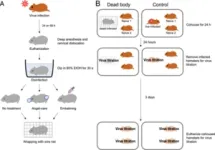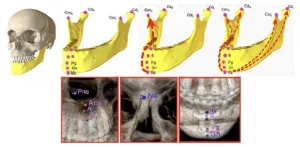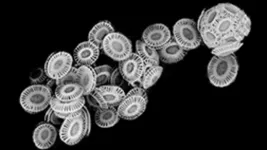(Press-News.org) There is increasing evidence that females of all ethnicities and ages are more salt sensitive than males, and that this propensity to hold onto more salt, which drives blood pressure up, increases after menopause.
Another important emerging bottom line is that healthy blood pressures might differ between the sexes, which means females might benefit from earlier and different intervention to avoid damage to their heart and vasculature.
“The realities are that women and men regulate our blood pressure differently and our blood pressures are different at baseline,” says Dr. Eric Belin de Chantemele, physiologist in the Vascular Biology Center at the Medical College of Georgia at Augusta University.
It’s generally thought that females are better protected against cardiovascular disease than males until menopause, when the risk is thought to level out. Laboratory studies in traditional hypertension rat models, like the Dahl Salt-Sensitive rat, have generally supported those ideas, including an equalization of risk in the two sexes following removal of the ovaries.
But in female humans and some mouse models the protection appears less absolute: Because more females are salt sensitive before menopause, and menopause exacerbates both its severity and prevalence, MCG scientists report in a review article featured on the cover of the American Heart Association journal Hypertension.
That supports yet another emerging concept that the sex chromosome XX predisposes females to salt sensitivity, presumably because females need to nearly double their fluid volume during pregnancy, and estrogen does help mitigate some of the related increased risk, at least until its levels drop after menopause, says Belin de Chantemele.
Work primarily in male humans and animal models feeds the misconception that women are less salt sensitive, Belin de Chantemele and his colleagues Dr. Jessica Faulkner, vascular physiologist in the MCG Department of Physiology and AU Graduate Student Candee T. Barris write.
“Salt sensitivity is one of the leading factors for hypertension. And, if you look at people who have treatment-resistant hypertension, which is most people, most are salt sensitive,” Belin de Chantemele says. “It’s very important to know the cause of that.”
Salt sensitivity means your body has an apparent natural tendency to hold onto salt rather than excrete excess in the urine. Salt sensitivity of blood pressure is when blood pressure decreases or increases more than 10% in response to how much salt you are consuming, the scientists say.
Salt sensitivity is a factor in about half of cases where the cause of hypertension is not obvious, like a kidney problem. It’s also a usual contributor to treatment resistant hypertension, and only about 1 in 4 adults have their hypertension under control, according to the Centers for Disease Control and Prevention.
There also is good human information that reducing salt intake reduces salt sensitivity and even more so in females, Belin de Chantemele says.
“We think it’s mostly the vasculature not relaxing in response to an intake of sodium that is leading to an elevation in pressure,” he says of the distinctive female handling of salt. Animal studies of salt sensitivity generally indicate that the kidneys, which should excrete more sodium when we consume too much, are working fine in females. In fact, human and lab animal evidence indicates that female kidneys are better at salt excretion, he says. The problem, it appears, is with the vasculature, because salt should also make the blood vessels relax.
“If you expand your blood vessels more then you will be able to keep your blood pressure stable, but if your vessels do not relax, that is how pressure goes up,” Belin de Chantemele says. “Later on, you also excrete sodium to reduce your blood volume, but the first response should be relaxation of your blood vessels.” And that is the way it works in those of us who are salt resistant. But apparently not so well in many females.
One of the other unique factors about females Belin de Chantemele and others are finding that appears important is that, also likely because their bodies are prepared to reproduce, they have high levels of the hormone aldosterone. Aldosterone is produced by the adrenal gland and has a direct effect on blood pressure by regulating salt-water balance in the body. Females also tend to have way more receptors for aldosterone, called mineralocorticoid receptors.
High levels of aldosterone are known to contribute to bad things for the body like widespread inflammation, stiff and scarred blood vessels, even enlargement of the heart. In females the scientists think and have some evidence that aldosterone is mostly deleterious to blood vessels, including their important ability to dilate to accommodate more blood volume in response to holding onto more salt. The scientists see this effect in their lab mice and in women.
“We think that what is happening is that salt-sensitive females cannot reduce their aldosterone production enough and we think that predisposes them to salt sensitivity,” Belin de Chantemele says.
Higher activation of the epithelial sodium channel, which prompts the body to hold onto more salt, is another negative for females. And, the renin-angiotensin-aldosterone system, which coordinates the work of the heart, blood vessels and kidneys, to regulate fluid and electrolyte balance in the body, also tends to be suppressed in females.
There are drugs that target aldosterone, including the old blood pressure medication spironolactone, as well as newer drugs like eplerenone and finerenone, which Belin de Chantemele has studied in the lab and which he has been advocating would be a good first-line treatment for females because they lower aldosterone action. He notes the drugs are getting better traction recently.
One of the MCG scientists’ many active pursuits is looking at whether aldosterone and estrogen levels have a connection, but they don’t have evidence of one at this point.
Important to the mix of better understanding sex differences in how males and females regulate blood pressure is the also emerging reality that, while female blood pressures tend to run lower than males, that doesn’t necessarily mean their pressures are good. Because while current guidelines have the same healthy blood pressure range for both sexes, it appears that females experience damage at a lower threshold or pressure.
Women tend to start with a lower pressure so it’s presumed they are not hypertensive but, particularly after menopause, the increases in pressure can be much larger for females, Belin de Chantemele says.
“I would say that the threshold for hypertension should be lower in women,” he says. “If we had a different threshold, we would notice changes in pressure faster, so we could hopefully intervene faster.” And when blood pressures start to rise, treatment for women should likely start at a lower pressure, he says.
While salt sensitivity is prevalent in both sexes and different ethnicities, large population studies worldwide indicate it’s most prevalent in females. For example, large studies in China indicate females have the biggest blood pressure response — up and down — to changes in salt levels in the diet. Big studies in individuals from the United States, France, Spain and Mexico, also indicate salt sensitivity is significantly more prevalent in females. They note that people of African American decent have the higher overall incidence regardless of their sex at 70%.
The two sex chromosomes, the XX that make a female and the XY that means male, as well as sex hormones like estrogen, likely are key to females’ propensity for this common condition. Genetics, like variations in the estrogen receptor, likely also contribute.
Evidence also indicates that females tend to like salt more than males, Belin de Chantemele says. Like many sex-related differences, the proclivity for salt likely relates to the physiological need to retain sodium, and the fluid which follows sodium, which is sufficient to sustain another life in pregnancy. There also is some evidence that the male hormone testosterone suppresses the appetite for salt.
Mice models that have been found to spontaneously develop salt-sensitive hypertension might be better for future studies of this condition in females than older models like the Dahl-Salt Sensitive rat, they write. Because what many have shown over and over in rats does not reproduce what is happening with females, Belin de Chantemele says.
He also suggests that all of us back off the salt intake. “There is nothing better than that,” he notes.
Read the full study.
END
Females of all ages, sexes have more salt- sensitive hypertension than males
2023-03-07
ELSE PRESS RELEASES FROM THIS DATE:
Mass General Brigham study finds virtual care team strategy improved treatment for heart failure patients
2023-03-06
Recent studies have provided strong evidence that patients with heart failure can benefit from medical therapies that can reduce risk of worsening symptoms and extend patients’ lives. But, despite new guidelines, adoption of these therapies has been slow, incomplete and inequitable. A prospective clinical study by investigators from Mass General Brigham evaluated a new approach to improve use of these therapies by putting in place a virtual care team, consisting of physicians and pharmacists, to help guide treatment strategies for patients seeking care at three Mass General Brigham hospitals: Brigham and Women’s Hospital (BWH), Brigham and Women’s Faulkner Hospital ...
Deep-learning-based anatomical landmark identification in CT scans
2023-03-06
Millions of people around the world undergo some type of orthodontic treatment each year due largely to developmental deformities in the jaw, skull, or face. Computed tomography (CT) imaging is the go-to technique for surgeons when planning such treatments, especially surgeries. This is because CT provides 3D images of the bones and teeth, which helps the surgeon analyze complex cases in detail and determine the best treatment procedure based on that.
During the CT scan, surgeons typically try to pinpoint specific anatomical landmarks in the images. These are distinct points in the human body that can be used as a reference to make measurements and assess a condition ...
The challenges of mining for electric-vehicle batteries
2023-03-06
In August 2022, Congress passed the Inflation Reduction Act (IRA). Signed by President Joe Biden, the legislation attempted to curb inflation, lower the deficit, and invest heavily into domestic clean energy.
One aspect of the bill was setting a market value-based target for battery-critical mineral content in electric vehicles (EVs). By 2027, for an EV to be tax-credit eligible, 80 percent of the market value of critical minerals in its battery must be extracted or processed domestically or by US free-trade partners (FTPs).
While this goal is well-intended, there are reasons to believe the mandate is unreachable and could create new problems.
In a commentary published ...
AI chatbot ChatGPT mirrors its users to appear intelligent
2023-03-06
LA JOLLA (March 6, 2023)—The artificial intelligence (AI) language model ChatGPT has captured the world’s attention in recent months. This trained computer chatbot can generate text, answer questions, provide translations, and learn based on the user’s feedback. Large language models like ChatGPT may have many applications in science and business, but how much do these tools understand what we say to them and how do they decide what to say back?
In new paper published in Neural Computation on February 17, 2023, Salk Professor Terrence Sejnowski, ...
Advancing engineering
2023-03-06
(Santa Barbara, Calif.) — UC Santa Barbara professors Thuc-Quyen Nguyen and Carlos G. Levi are among 106 new members of the National Academy of Engineering. Academy membership honors those who have made outstanding contributions to “engineering research, practice or education, including, where appropriate, significant contributions to the engineering literature” and to “the pioneering of new and developing fields of technology, making major advancements in traditional fields of engineering, or developing/implementing innovative approaches to engineering education.”
“Our campus ...
Microscopic chalk discs in oceans play a key role in earth’s carbon cycle by propagating viruses
2023-03-06
A Rutgers-led team of scientists studying virus-host interactions of a globally abundant, armor-plated marine algae, Emiliania huxleyi, has found that the circular, chalk plates the algae produce can act as catalysts for viral infection, which has vast consequences for trillions of microscopic oceanic creatures and the global carbon cycle.
“In a drop of seawater, there will be about 1,000 to 10,000 E. huxleyi cells, and about 10 million viruses,” said Kay Bidle, a professor in the Department of ...
WVU water quality expert develops public tool for diagnosing health of America’s streams
2023-03-06
A model for predicting the levels of oxygen in water, developed by West Virginia Universityresearcher Omar Abdul-Aziz, gives citizen scientists nationwide a tool for taking action on stream pollution.
“I have been looking at water quality data for 20 years,” said Abdul-Aziz, an associate professor at the Benjamin M. Statler College of Engineering and Mineral Resources. “I can tell you that a big percentage of streams in the United States are polluted. Urban streams are getting dumpster runoff, stormwater ...
Iron & the brain: Where and when neurodevelopmental disabilities may begin during pregnancy
2023-03-06
The cells that make up the human brain begin developing long before the physical shape of the brain has formed. This early organizing of a network of cells plays a major role in brain health throughout the course of a lifetime. Numerous studies have found that mothers with low iron levels during pregnancy have a higher risk of giving birth to a child that develops cognitive impairments like autism, attention deficit syndrome, and learning disabilities. However, iron deficiency is still prevalent in ...
Long-term intermittent fasting reduces COVID-19 heart failure complications and death in patients with previous heart disease
2023-03-06
Intermittent fasting, especially when done over the course of decades, can have positive effects on metabolic and cardiovascular health. Now, a new study by researchers at Intermountain Health in Salt Lake City finds that it may also add an extra layer of protection from heart-related COVID-19 complications in people who had already sought cardiac care.
“We already know that regular fasting over long periods of time can lead to overall health improvements. Here we found that it may also lead to better outcomes in COVID-19 patients who required a cardiac catheterization,” said Benjamin Horne, PhD, director of cardiovascular and genetic epidemiology ...
Study finds residual inflammation after statin therapy strongly predicted cardiovascular events, death
2023-03-06
New evidence released today from a study of 31,245 patients already taking statin therapy indicates that inflammation may be a more powerful predictor of risk of future cardiovascular events—such as heart attack and stroke — than “bad” cholesterol. Treatments that aggressively lower vascular inflammation need to be incorporated into daily practice if doctors are to maximize patient outcomes, according to the study’s corresponding author, Paul Ridker, MD, a preventive cardiologist at Brigham and Women’s Hospital, a founding member of the Mass General ...







